Dr. Ray L. Winstead
Professor of Biology (retired), Indiana University of
Pennsylvania
|
Identifying Individual Birds When They Are Nearby Is Fun!
In general, look carefully
for a unique, distinctive difference in feather pattern in an
individual, such as a noticeable feather that is different from other
individuals of the same species. For example, male Downy Woodpeckers
have a black cap, but "White Feather" comes to my hand and has a
noticeable, distinctive white feather in the black cap - just to his right of the midline:
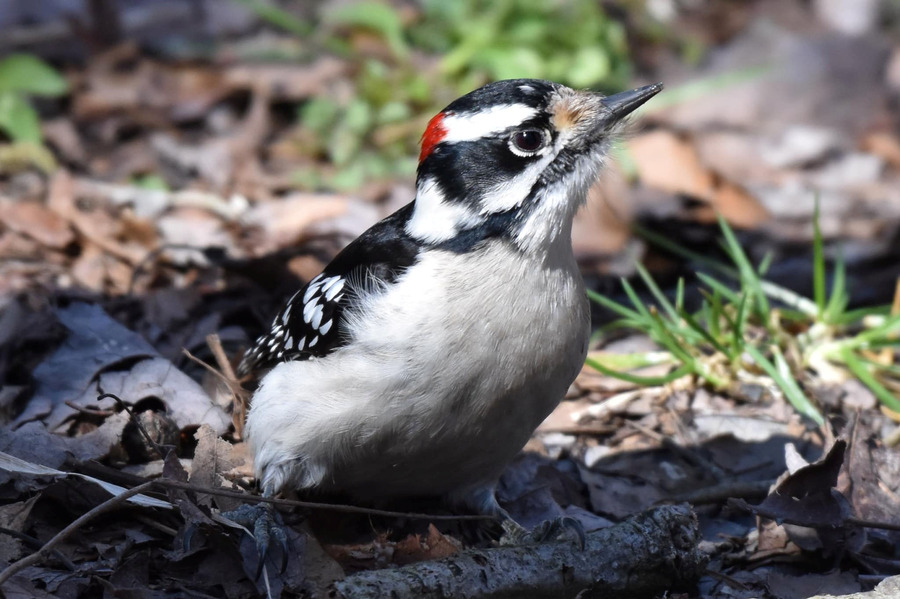
Photo by Lynda Brown.
Video by Lynda Brown.
Likewise, the Black-capped Chickadee
"Left-Eye" has a noticeable, white feather dot just over his left eye in
the black cap.
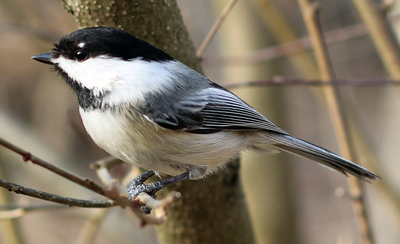
Photo by Deidre States Smith.
Identifying Individual Black-capped Chickadees
Just
as there are differences among the physical and behavioral
characteristics of people, you can also identify individual chickadees
by the variations in their feather patterns and behavioral
characteristics. You are encouraged to have fun doing this while feeding
the chickadees out of your hands at Blue Spruce Park. Field Guides will
show the basic feather patterns of a bird species, and these basic
patterns are essential to correctly identify a particular species.
However, if you are observant, you will also discover that individual
chickadees have their own unique physical characteristics, as well as
their own "personality" traits and idiosyncrasies. (For example, at the bottom of this page
see the descriptions of the chickadees that regularly came down to my
hand in 2013.)
The
smaller illustration below shows the basic "bib" pattern of a
Black-capped Chickadee in a field guide, but each chickadee will have
its own variation of that basic pattern.
The larger photos below are of
specific Blue Spruce chickadees. On the first bird, note that the edges
of the bib are not sharp and have more white coming down into the black
bib on the bird's left side. On that same bird also note on the bird's
right side how some black comes down more from the bib into the chest.
When you are observing individual birds especially note the border
between the black bib and the white chest. That's where I notice a lot
of variation, with some birds having a sharper line, while most birds
have a ragged or gradual transition from the bib to the chest. Sometimes
there will be such a combination of black and white at the edge that the
border looks gray. The sides of the bib are often very different from
bird to bird, with some birds having different size vertical "sideburns"
(with additional variation up and down) at the side edges of the bib.
See the second photo for one variation of this.
The best way to tell the chickadees apart is
usually the
variation in the margins of their bibs, as mentioned above and shown below. However, there are
exceptions. “Left-Eye” is a Black-capped Chickadee, easily recognizable by a
white/gray dot over his left eye. In 2019 - 2020, the dot was bright white, but
in 2020 - 2021, it was gray. When I first saw the dot in the first Fall, I thought it was
just a feather temporarily out of place, but it was prominent the entire Spring,
so my conclusion is that it is a unique white feather. “Left-Eye” is a
dependable regular. He usually holds back a little on
a nearby branch and waits for an opening, unlike the more assertive chickadees.
“Left-Eye” seems to be more wide-ranging than the others. When I am just walking
around in different sections of the park, “Left-Eye” is the one that accosts me
in new places. Deidre States Smith was able to get a good photograph of
"Left-Eye:"

Click Image for Larger Image
The point is - when the
bird is nearby or on your hand, look for the variations and you will
learn to see individual birds. Then look for, and you will see,
individual behavioral patterns you can associate with the individuals
you can identify. For example, some individuals are very aggressive
toward other individuals and more vocal, while others are more hesitant
on a branch before coming to someone's hand. The chickadees are fast,
and, frankly, their individual identifications were easier in the past
when there were fewer birds to observe coming to my hand.
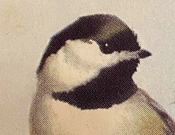
Field Guide Illustration |
|
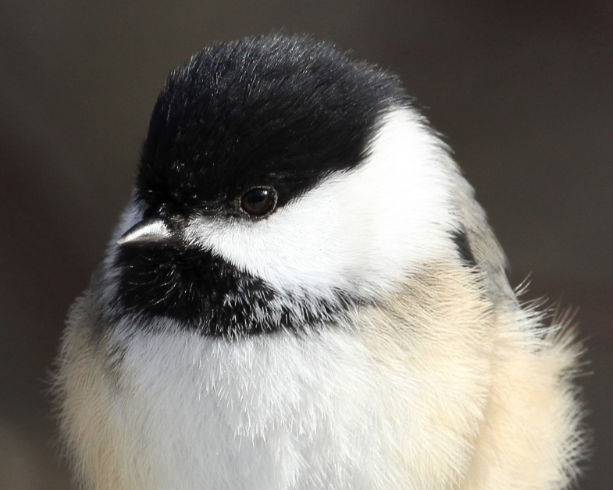
A specific Blue Spruce Chickadee |
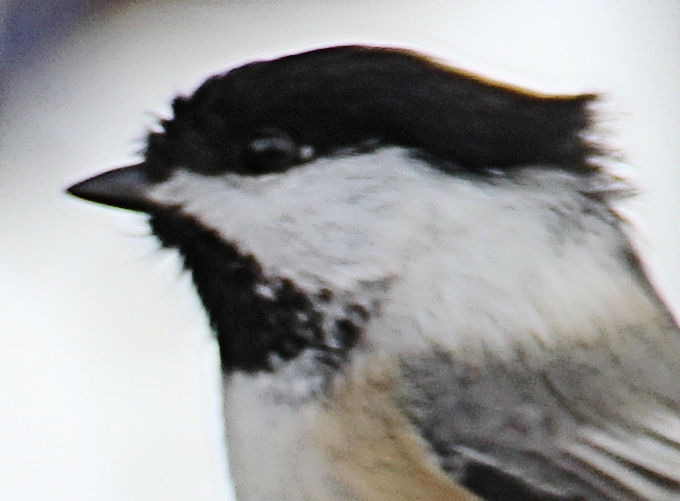
A different specific Blue Spruce Chickadee |
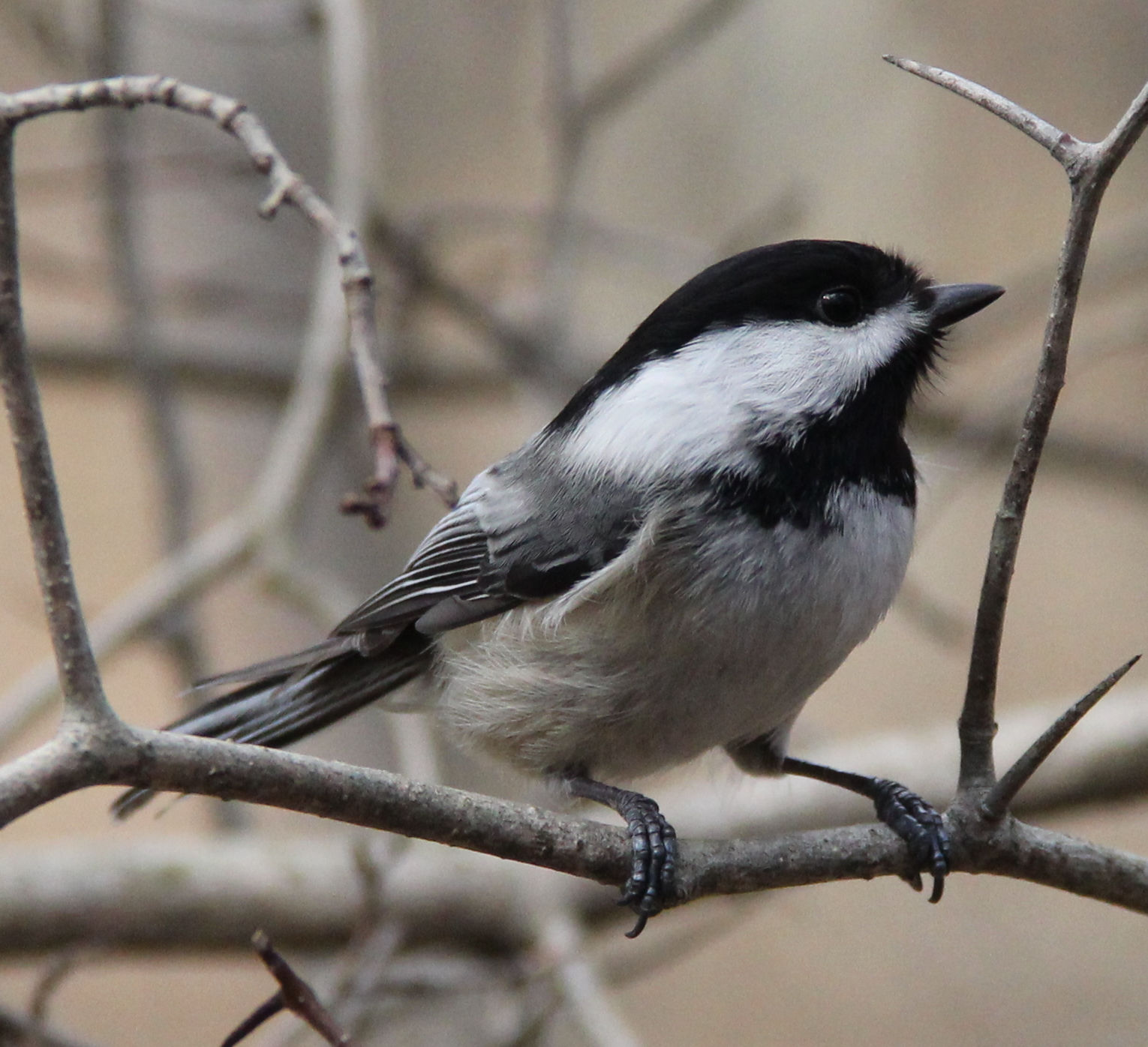
A different specific Blue Spruce Chickadee |
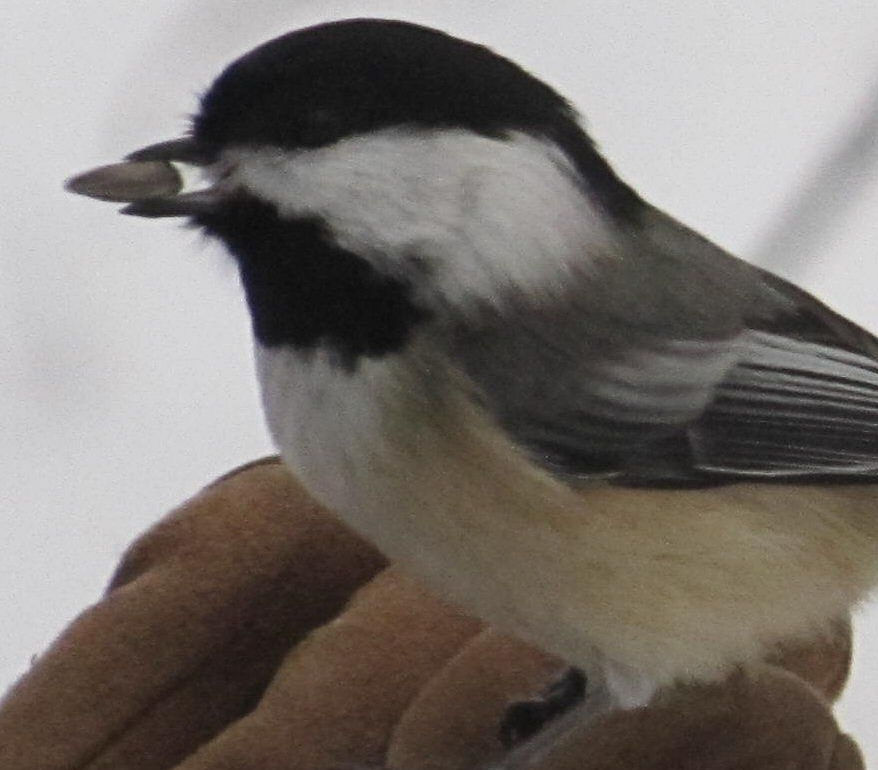
A different specific Blue Spruce Chickadee |
With variation, chickadees live about two years in the wild. I do see individual
chickadees that I can identify, e.g., from individual feather pattern
variations, from one winter to the next winter, but I have not seen an
individual that I can identify for more than two years. The individuals from the
previous year show the new birds In the fall that landing on my hand is OK. The
new birds initially are noticeably very watchful from nearby branches, then
swooping, and then just touching my hand briefly before they become regulars. In
2021 - 2022, the chickadees Elisha and Elijah were regulars (identified by
very small, unique white feather patches on their caps), and both of them are regulars again
in 2022 - 2023. (The prophet Elisha was
ridiculed and called
bald by young men.)
Identifying Individual White-breasted Nuthatches
11-27-2020. The main point of this note is to
encourage you to go out to Blue Spruce Park and look for details – to increase
your enjoyment of the out-of-doors. Today, MORE than 25 INDIVIDUAL birds fed out
of my hand at Blue Spruce Park. (The only way to get an estimate is for me to
count them as they fly into the branches in front of me as they wait for me to
get the food out. I call them in by shaking my seeds as I walk down Getty Run
Trail below the playground to the meeting place. They know the drill. After
that, too many birds are flying in and out to get a good count.) All four
White-breasted Nuthatches came to my hand today. The two males have very black
caps on the tops of their heads, the same color as the black of the collars on
the backs of their necks. One male is “Streak,” recognizable by a heavy black
streak behind each eye, along with more gray on the whitish face. He chases the
other three nuthatches - but comes to my hand the least. “Merrill” (possibly
Merle, Jr, the son of “Merle” from a few years ago – similar looking but sheer
conjecture) is the other male, and he has a whiter face with only a little gray
– and no prominent streaks behind the eyes. He is a regular to my hand. The two
females have gray caps on the tops of their heads, noticeably gray in contrast
to the dark black collars on the backs of their necks. “Norma” has the normal
female pattern, but she does have a darker gray cap - still gray in contrast to
the black cap of the male and to the black collar on the back of her neck.
“Norma” always comes to my hand many more times than the other nuthatches. The
other female is “Window,” and she has a lighter gray cap with the gray extending
into, and replacing, the black of the middle of her black collar, i.e., a small
gray window in the black collar. “Window,” although often coming to my hand,
too, seems to prefer going to the ground at my feet to pick up seeds that have
been knocked out of my hand by other birds. So, be on the lookout for “Streak,”
“Merrill,” “Norma,” and “Window” when you go out to feed the birds at Blue
Spruce. (Link
to close-up photo of "Window" in November 2019 - also see the video and original
photo with Maddy. In February 2021, "Window's" gray window is smaller.)
Note the photo below of a White-breasted Nuthatch
with a noticeable, unique white dot on the front of the gray cap - just above
the base of the beak. She is now a regular coming down to my hand - September
2023.
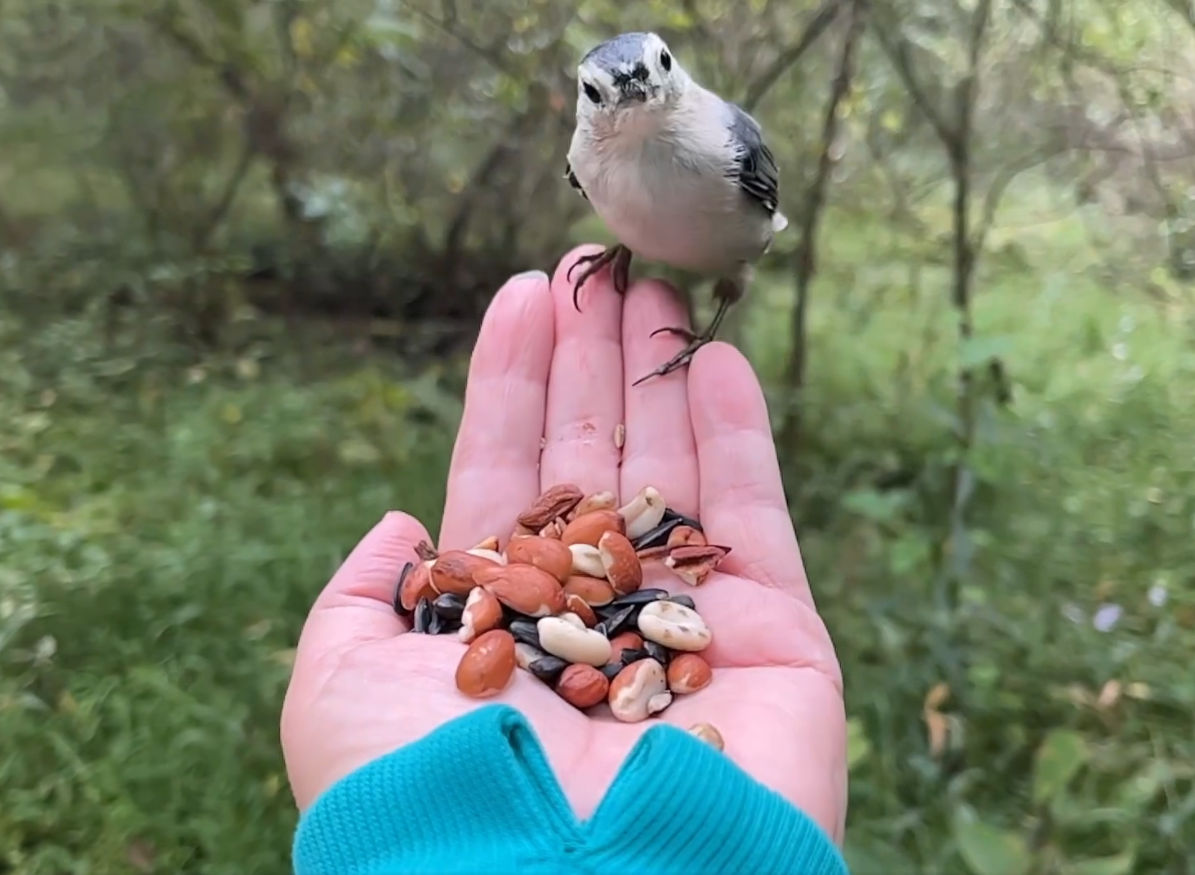
Female White-breasted Nuthatch
"Dot" = "Dorothy" 9-26-2023
Photo by Cheri Widzowski
---------
In the last half of the 2018 - 2019 winter, a female
Downy Woodpecker came down
to my hand as a regular, after many days of getting closer and closer and
carefully observing the other birds. This year (February 2022) another female Downy Woodpecker
is going through that same process, and today she was on a branch only a foot
away. Any day now I think she will come down. Update: she is now coming down to
my hand! February 2023: a female Downy Woodpecker is now a regular coming down
to my hand - usually landing on my leg, side, or arm first before flying/jumping
from there to my hand. A male keeps getting closer.
The best way to tell the chickadees apart is
usually the
variation in the margins of their bibs, as mentioned above.
A reminder that a good combination of seeds to
feed the birds from your hand is the smaller black oil sunflower seeds and
peanut splits. The nuthatches and titmice much prefer the peanuts, but the
chickadees seem to have their own individual preferences between the two.
So, “Be Aware” of what is going on around you and
check out Blue Spruce Park!
Individual Chickadee Descriptions December 2013
George I: by far the most
dominant individual over all the chickadees, all the titmice, and even over the
nuthatch; chases the others away at times and will even physically fly into
another bird already on my hand to knock them off - fights with titmice will
even involve locked feet and falling to the ground; call is noticeably the
lowest pitched of any of the other chickadees; the black bib has a sharp edge
with the white underneath but there are small black whisker marks out both
sides; often flies directly to my hand from far away without landing on a
nearby branch as the others do - you can see him coming through the woods or
down the trail after having taken a seed somewhere else; lands in my hand with
flat feet, so I don't even feel the claws; flies away with no push-off,
especially in comparison to the titmice; stays on my hand the longest and is the
most picky - will pick up a seed and possibly reject it and pick up another;
much more than the others will pick up two seeds at a time before flying off.
Will sometimes fly back to my hand with a seed already in his mouth as he chases
off another bird that just came to my hand after he just left.
Sharpie: the second individual who landed on my
hand this Fall, after coming close and observing George I for a while; often
lands oriented vertically, so that the sharp claws are felt; the black bib has a
broad gray transition border (actually black feather dots on white) with a more
ragged edge on the bird's right side.
Hover: the third individual who landed on my hand
this Fall after observing George I and Sharpie; for the first week or so each
day often hovered just before landing on my hand, but usually does not do that
any more; black bib has a narrow gray transition border without other ragged
edges.
Sideburns: noticeable "whisker marks" = sideburns
on both sides of black bib, very similar to but greater than those of George I,
however the behavior of Sideburns is that this individual is still the most
hesitant and reluctant to come to any hand - exact opposite of George I - will
come close many times and then abort - but after a while then comes regularly,
but usually waiting for an open chance when other birds are not on my hand -
will sit on a nearby branch the longest before coming to my hand.
George II: has black bib with a sharp edge with the
white underneath but there are no black whisker marks - a pattern most closely
illustrated in a field guide. Not always present with the rest of the flock.
Previous
Chickadees Home
Next


Christian
Essentials
Dr. Winstead's Blood
Pressure Tracker: Free Templates for Graphing Blood Pressure in Microsoft
Excel
Dr. Winstead's Current Local and World Standard
Percentage Metric Time Clock
Blue Spruce Park Chickadees
Dr. Ray L.
Winstead
rw ( at ) raywinstead ( dot ) com
bs






